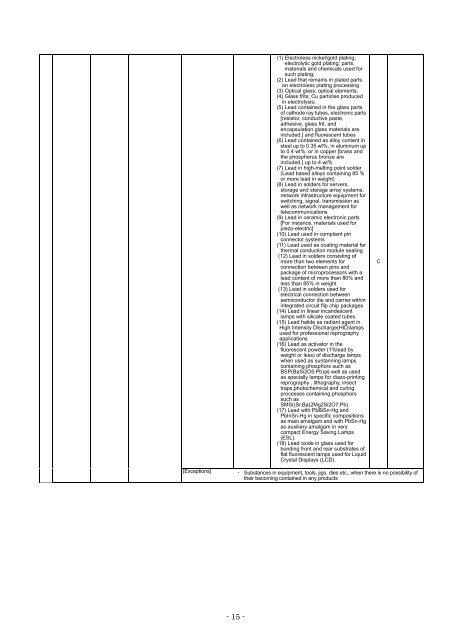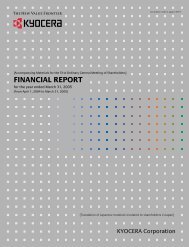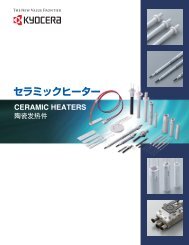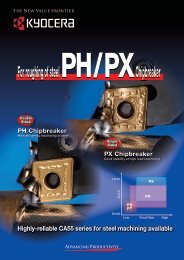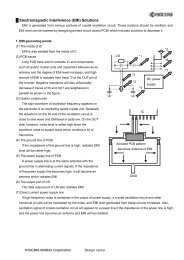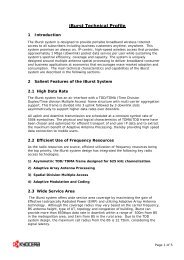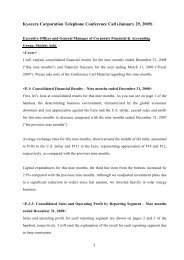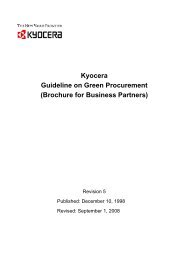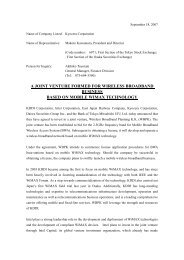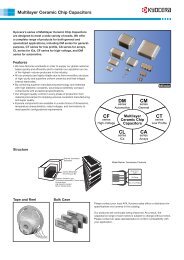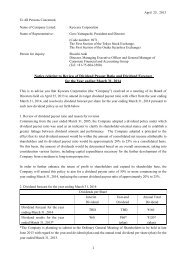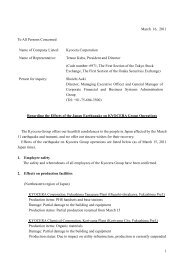Brochure for Business Partners - Kyocera
Brochure for Business Partners - Kyocera
Brochure for Business Partners - Kyocera
You also want an ePaper? Increase the reach of your titles
YUMPU automatically turns print PDFs into web optimized ePapers that Google loves.
- 15 -<br />
(1) Electroless nickel/gold plating;<br />
electrolytic gold plating; parts,<br />
materials and chemicals used <strong>for</strong><br />
such plating;<br />
(2) Lead that remains in plated parts<br />
on electroless plating processing<br />
(3) Optical glass; optical elements;<br />
(4) Glass frits; Cu particles produced<br />
in electrolysis;<br />
(5) Lead contained in the glass parts<br />
of cathode ray tubes, electronic parts<br />
[resistor, conductive paste,<br />
adhesive, glass frit, and<br />
encapsulation glass materials are<br />
included.] and fluorescent tubes<br />
(6) Lead contained as alloy content in<br />
steel up to 0.35 wt%, in aluminum up<br />
to 0.4 wt%, or in copper [brass and<br />
the phosphorus bronze are<br />
included.] up to 4 wt%<br />
(7) Lead in high-melting point solder<br />
(Lead based alloys containing 85 %<br />
or more lead in weight)<br />
(8) Lead in solders <strong>for</strong> servers,<br />
storage and storage array systems,<br />
network infrastructure equipment <strong>for</strong><br />
switching, signal, transmission as<br />
well as network management <strong>for</strong><br />
telecommunications<br />
(9) Lead in ceramic electronic parts<br />
[For instance, materials used <strong>for</strong><br />
piezo-electric]<br />
(10) Lead used in compliant pin<br />
connector systems<br />
(11) Lead used as coating material <strong>for</strong><br />
thermal conduction module sealing<br />
(12) Lead in solders consisting of<br />
more than two elements <strong>for</strong><br />
connection between pins and<br />
package of microprocessors with a<br />
lead content of more than 80% and<br />
less than 85% in weight<br />
(13) Lead in solders used <strong>for</strong><br />
electrical connection between<br />
semiconductor die and carrier within<br />
integrated circuit flip chip packages<br />
(14) Lead in linear incandescent<br />
lamps with silicate coated tubes.<br />
(15) Lead halide as radiant agent in<br />
High Intensity Discharge(HID)lamps<br />
used <strong>for</strong> professional reprography<br />
applications<br />
(16) Lead as activator in the<br />
fluorescent powder (1%lead by<br />
weight or less) of discharge lamps<br />
when used as suntanning lamps<br />
containing phosphors such as<br />
BSP(BaSi2O5:Pb)as well as used<br />
as specially lamps <strong>for</strong> diazo-printing<br />
reprography , lithography, insect<br />
traps,photochemical and curing<br />
processes containing phosphors<br />
such as<br />
SMS((Sr,Ba)2Mg2Si2O7:Pb).<br />
(17) Lead with PbBiSn-Hg and<br />
PbInSn-Hg in specific compositions<br />
as main amalgam and with PbSn-Hg<br />
as auxiliary amalgam in very<br />
compact Energy Saving Lamps<br />
(ESL).<br />
(18) Lead oxide in glass used <strong>for</strong><br />
bonding front and rear substrates of<br />
flat fluorescent lamps used <strong>for</strong> Liquid<br />
Crystal Displays (LCD).<br />
[Exceptions] Substances in equipment, tools, jigs, dies etc., when there is no possibility of<br />
their becoming contained in any products<br />
C


